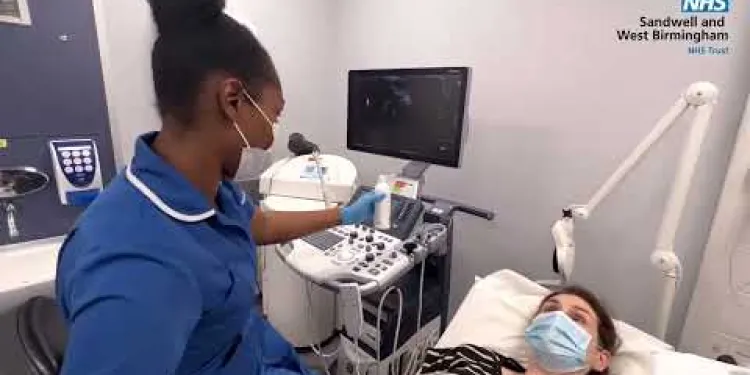Important Information On Using This Service
- Ergsy carefully checks the information in the videos we provide here.
- Videos shown by YouTube after a video has completed have NOT been reviewed by ERGSY.
- To view, click the arrow in the center of the video.
Using Subtitles and Closed Captions
- Most of the videos you find here will have subtitles and/or closed captions available.
- You may need to turn these on and choose your preferred language.
Turn Captions On or Off
- Go to the video you'd like to watch.
- If closed captions (CC) are available, settings will be visible on the bottom right of the video player.
- To turn on captions, click settings.
- To turn off captions, click settings again.
Find A Professional
More Items From Ergsy search
-

Does the menopause just happen suddenly?
Relevance: 100%
-

Does Menopause Only Happen in Your 50's? | NHS 24
Relevance: 94%
-

What is the Postcode Lottery in the UK?
Relevance: 89%
-

Post Menopausal Bleeding Clinic | A Guide to What Happens at An Appointment
Relevance: 85%
-

Is the Postcode Lottery a scam?
Relevance: 80%
-

How are Postcode Lottery winners selected?
Relevance: 75%
-

What can you win in the Postcode Lottery?
Relevance: 74%
-

What should I do if I start bleeding during early pregnancy? | NHS
Relevance: 65%
-

Menopause Myths
Relevance: 65%
-

How does the Postcode Lottery work?
Relevance: 62%
-

Bleeding from the bottom rectal bleeding
Relevance: 61%
-

Bleeding from the bottom rectal bleeding
Relevance: 60%
-

Living with the menopause
Relevance: 59%
-

What charities does the Postcode Lottery support?
Relevance: 59%
-

How do you sign up for the Postcode Lottery?
Relevance: 57%
-

How do I know if I have postnatal depression? | NHS
Relevance: 55%
-

Postnatal Depression - Leanne's Story
Relevance: 53%
-

Men Don't Need to Know about Menopause | NHS 24
Relevance: 52%
-

How much does it cost to play the Postcode Lottery?
Relevance: 51%
-

Can you play the Postcode Lottery if you live outside the UK?
Relevance: 50%
-

Heavy periods (heavy menstrual bleeding)
Relevance: 50%
-

Living with the menopause
Relevance: 48%
-

Let's Talk About Menopause - The Queen Elizabeth Hospital King's Lynn NHS Foundation Trust
Relevance: 47%
-

Postnatal Depression
Relevance: 46%
-

Talking menopause with your GP
Relevance: 44%
-

Is there a minimum age requirement to play the Postcode Lottery?
Relevance: 44%
-

How are Postcode Lottery funds allocated?
Relevance: 43%
-

Talking menopause with your GP
Relevance: 42%
-

Postpartum Health: Mother and Baby
Relevance: 39%
-

How do I know if I’ve won in the Postcode Lottery?
Relevance: 39%
-

How often are Postcode Lottery draws held?
Relevance: 39%
-

Does the Postcode Lottery have a mobile app?
Relevance: 39%
-

How can I cancel my Postcode Lottery subscription?
Relevance: 38%
-

What should I do if I experience severe pain or bleeding after the test?
Relevance: 34%
-

Is it possible for hackers to use my social media posts to cause harm?
Relevance: 33%
-

Is the Postcode Lottery a charity?
Relevance: 30%
-

Navigating Personal Injury Claims: What You Need to Know Post-2023
Relevance: 27%
-

What happens if I move to a new postcode?
Relevance: 27%
-

Haemophilia
Relevance: 26%
-

What are the side effects of Aspirin?
Relevance: 25%
Post Menopausal Bleeding Clinic | A Guide to What Happens at An Appointment
Introduction to Post Menopausal Bleeding
Post Menopausal Bleeding (PMB) refers to any vaginal bleeding that occurs more than 12 months after a woman's last menstrual period. It can be a cause for concern and might indicate underlying health issues. Understanding what happens during a clinic appointment can help alleviate anxiety and prepare you for what to expect.Booking an Appointment
If you experience PMB, your first step should be to contact your GP. They will perform an initial evaluation and may refer you to a specialist post menopausal bleeding clinic. In the United Kingdom, these clinics are equipped to diagnose and treat conditions related to PMB, ensuring you receive the best possible care.Initial Consultation
Upon arriving at the clinic, you will have an initial consultation with a healthcare professional. They will take a comprehensive medical history, including details about your menstrual cycle, any menopausal symptoms, and your general health. Be prepared to discuss any medications you're taking, as well as any family history of gynaecological problems.Physical Examination
A physical examination is a crucial part of your clinic visit. This usually includes a pelvic examination to check for abnormalities in the reproductive organs. The healthcare provider may also conduct a cervical screening test (smear test) to rule out any cervical issues.Diagnostic Tests
To determine the cause of PMB, a range of diagnostic tests might be conducted. These can include: - **Transvaginal Ultrasound:** This imaging test provides a clear picture of the uterus, ovaries, and endometrial lining. - **Endometrial Biopsy:** A small sample of the uterine lining is taken for further analysis. - **Hysteroscopy:** This procedure involves inserting a small camera into the uterus to look for abnormalities.Discussion of Results and Treatment Plan
Once the diagnostic tests are complete, the healthcare provider will discuss the results with you. If a cause for the bleeding is identified, they will outline a treatment plan. This could include medication, lifestyle changes, or in some cases, surgical intervention. Conditions like polyps, fibroids, or endometrial hyperplasia are commonly treated at these clinics.Follow-Up Care
Follow-up appointments are often necessary to monitor your condition and the effectiveness of the treatment plan. Regular check-ups will help ensure that any ongoing issues are managed effectively.Emotional Support
Experiencing post menopausal bleeding can be stressful. UK clinics often provide access to counselling services or support groups to help manage any emotional challenges you may face.Conclusion
Understanding what to expect during a post menopausal bleeding clinic visit can provide reassurance and help you feel more in control of your health. These clinics are dedicated to providing thorough care and ensuring any underlying issues are promptly addressed, offering peace of mind and effective treatment solutions.Post Menopausal Bleeding Clinic: A Guide to What Happens at an Appointment
Introduction
Post menopausal bleeding (PMB) can be a concerning experience for women who have already gone through menopause. In the United Kingdom, specialised clinics are available to assess and treat this condition. Understanding what happens during an appointment can help alleviate anxiety and prepare individuals for their visit.
Initial Consultation
Upon arrival at the clinic, you will have an initial consultation with a healthcare professional, typically a gynaecologist or specialist nurse. They will take a detailed medical history, including questions about your menstrual history, when the bleeding started, its frequency, and other symptoms you might be experiencing.
Physical Examination
Following the consultation, a physical examination may be conducted. This usually includes a pelvic exam to check for abnormalities in the uterus, cervix, or other reproductive organs. The healthcare provider will be gentle and explain each step to ensure your comfort during the procedure.
Diagnostic Tests
To further investigate the cause of post menopausal bleeding, certain tests might be recommended. These could include an ultrasound scan to examine the uterus and surrounding structures, and a biopsy to test a sample of uterine tissue. Blood tests may also be performed to rule out other potential issues.
Treatment and Follow-Up
The results of the tests will guide the treatment plan. Common causes of PMB include hormone replacement therapy effects, benign growths like polyps, or in rare cases, cancer. Once a diagnosis is made, the healthcare provider will discuss treatment options, which may involve medication, surgical procedures, or ongoing monitoring.
Conclusion
Attending a post menopausal bleeding clinic is an important step in addressing unexpected bleeding. The appointment process is designed to diagnose the cause of your symptoms and plan an effective treatment strategy, ensuring you receive the best care and support available in the UK.
Frequently Asked Questions
What is postmenopausal bleeding?
Postmenopausal bleeding is any vaginal bleeding that occurs after a woman has gone 12 months without a menstrual period (menopause). It can be a sign of a health issue and should be evaluated by a healthcare professional.
Why is it important to see a doctor if I experience postmenopausal bleeding?
It's important to see a doctor because postmenopausal bleeding could indicate conditions ranging from benign (such as polyps or hormone imbalances) to more serious issues such as cancer of the endometrium.
What happens during my appointment at a postmenopausal bleeding clinic?
During your appointment, you will likely have a discussion about your medical history, a physical exam, and some tests, such as an ultrasound or a biopsy, to determine the cause of the bleeding.
What questions should I expect at the clinic?
You may be asked about the timing and frequency of your bleeding, any other symptoms you experience, your family medical history, and any medications you are taking.
What tests might be performed during the appointment?
Common tests include pelvic examinations, ultrasounds to look at the structure of the uterus and ovaries, and endometrial biopsies to test the tissue of the uterine lining.
Are there any specific preparations needed for the appointment?
Generally, no special preparations are needed, but it may be helpful to write down your symptoms, any questions you have, and a list of medications you're taking. Check with your clinic for any specific instructions.
How should I manage anxiety before my appointment?
Managing anxiety can be aided by learning about the procedures that may take place, bringing a friend or family member for support, and discussing any concerns with your GP ahead of time.
Will I receive a diagnosis the same day?
A diagnosis may not be immediately possible; some test results can take time. Your doctor will discuss the next steps after the initial evaluation and testing.
What are the common causes of postmenopausal bleeding?
Common causes include hormone therapy, endometrial atrophy, polyps, or more serious conditions such as endometrial hyperplasia or cancer.
Can postmenopausal bleeding be treated?
Treatment depends on the cause but may include medications like hormone therapy or surgical options, such as the removal of polyps or the lining of the uterus.
Is postmenopausal bleeding always a sign of cancer?
Not always, but because it can be a symptom of endometrial or other gynecological cancers, it's important to seek medical evaluation.
What role does lifestyle play in managing postmenopausal health?
A healthy lifestyle, including a balanced diet, regular exercise, and avoiding smoking, can help maintain postmenopausal health and potentially reduce the risk of certain conditions.
How long do appointments at the clinic typically last?
Appointments can vary but typically last from 30 minutes to an hour, depending on the number of tests performed.
Will I always need a follow-up appointment?
Follow-up appointments may be necessary depending on the results of initial tests or if further monitoring or treatment is required.
How prevalent is postmenopausal bleeding?
It's relatively common, affecting around 10% of postmenopausal women at some point. However, any bleeding should be evaluated by a healthcare provider.
Useful Links
- Ergsy carfully checks the information in the videos we provide here.
- Videos shown by Youtube after a video has completed, have NOT been reviewed by ERGSY.
- To view, click the arrow in centre of video.
- Most of the videos you find here will have subtitles and/or closed captions available.
- You may need to turn these on, and choose your preferred language.
- Go to the video you'd like to watch.
- If closed captions (CC) are available, settings will be visible on the bottom right of the video player.
- To turn on Captions, click settings .
- To turn off Captions, click settings again.
More Items From Ergsy search
-

Does the menopause just happen suddenly?
Relevance: 100%
-

Does Menopause Only Happen in Your 50's? | NHS 24
Relevance: 94%
-

What is the Postcode Lottery in the UK?
Relevance: 89%
-

Post Menopausal Bleeding Clinic | A Guide to What Happens at An Appointment
Relevance: 85%
-

Is the Postcode Lottery a scam?
Relevance: 80%
-

How are Postcode Lottery winners selected?
Relevance: 75%
-

What can you win in the Postcode Lottery?
Relevance: 74%
-

What should I do if I start bleeding during early pregnancy? | NHS
Relevance: 65%
-

Menopause Myths
Relevance: 65%
-

How does the Postcode Lottery work?
Relevance: 62%
-

Bleeding from the bottom rectal bleeding
Relevance: 61%
-

Bleeding from the bottom rectal bleeding
Relevance: 60%
-

Living with the menopause
Relevance: 59%
-

What charities does the Postcode Lottery support?
Relevance: 59%
-

How do you sign up for the Postcode Lottery?
Relevance: 57%
-

How do I know if I have postnatal depression? | NHS
Relevance: 55%
-

Postnatal Depression - Leanne's Story
Relevance: 53%
-

Men Don't Need to Know about Menopause | NHS 24
Relevance: 52%
-

How much does it cost to play the Postcode Lottery?
Relevance: 51%
-

Can you play the Postcode Lottery if you live outside the UK?
Relevance: 50%
-

Heavy periods (heavy menstrual bleeding)
Relevance: 50%
-

Living with the menopause
Relevance: 48%
-

Let's Talk About Menopause - The Queen Elizabeth Hospital King's Lynn NHS Foundation Trust
Relevance: 47%
-

Postnatal Depression
Relevance: 46%
-

Talking menopause with your GP
Relevance: 44%
-

Is there a minimum age requirement to play the Postcode Lottery?
Relevance: 44%
-

How are Postcode Lottery funds allocated?
Relevance: 43%
-

Talking menopause with your GP
Relevance: 42%
-

Postpartum Health: Mother and Baby
Relevance: 39%
-

How do I know if I’ve won in the Postcode Lottery?
Relevance: 39%
-

How often are Postcode Lottery draws held?
Relevance: 39%
-

Does the Postcode Lottery have a mobile app?
Relevance: 39%
-

How can I cancel my Postcode Lottery subscription?
Relevance: 38%
-

What should I do if I experience severe pain or bleeding after the test?
Relevance: 34%
-

Is it possible for hackers to use my social media posts to cause harm?
Relevance: 33%
-

Is the Postcode Lottery a charity?
Relevance: 30%
-

Navigating Personal Injury Claims: What You Need to Know Post-2023
Relevance: 27%
-

What happens if I move to a new postcode?
Relevance: 27%
-

Haemophilia
Relevance: 26%
-

What are the side effects of Aspirin?
Relevance: 25%